LOTUS ELISE 2005 Manual PDF
Manufacturer: LOTUS, Model Year: 2005, Model line: ELISE, Model: LOTUS ELISE 2005Pages: 205, PDF Size: 4.51 MB
Page 71 of 205
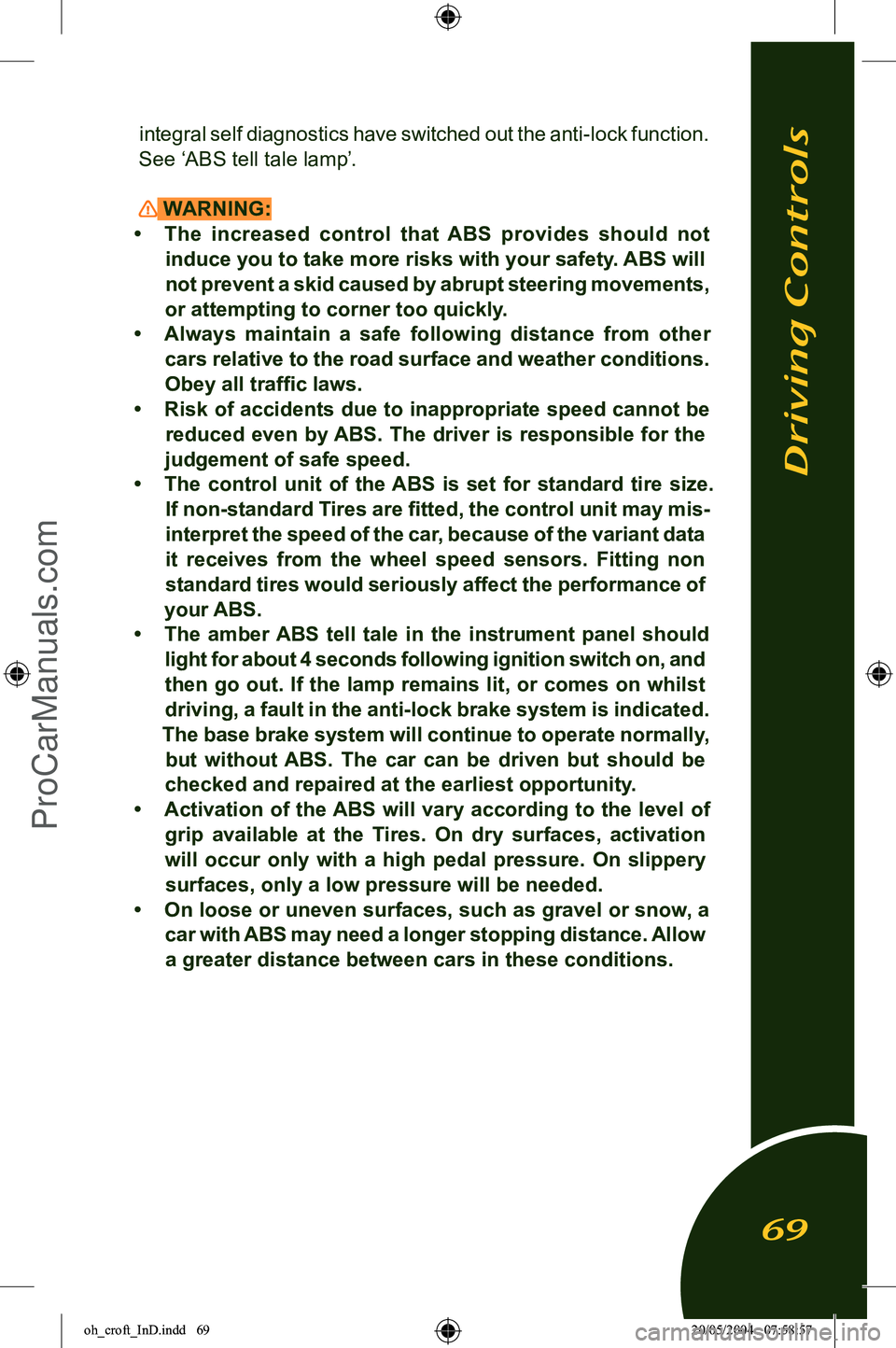
integral self diagnostics have switched out the anti-lock function.
See ‘ABS tell tale lamp’.
WARNING:
• The increased control that ABS provides should not induce you to take more risks with your safety. ABS will
not prevent a skid caused by abrupt steering movements,
or attempting to corner too quickly.
• Always maintain a safe following distance from other cars relative to the road surface and weather conditions.
Obey all traffic laws.
• Risk of accidents due to inappropriate speed cannot be reduced even by ABS. The driver is responsible for the
judgement of safe speed.
• The control unit of the ABS is set for standard tire size. If non-standard Tires are fitted, the control unit may mis-
interpret the speed of the car, because of the variant data
it receives from the wheel speed sensors. Fitting non standard tires would seriously affect the performance of
your ABS.
• The amber ABS tell tale in the instrument panel should light for about 4 seconds following ignition switch on, and
then go out. If the lamp remains lit, or comes on whilst driving, a fault in the anti-lock brake system is indicated.
The base brake system will continue to operate normally,
but without ABS. The car can be driven but should be
checked and repaired at the earliest opportunity.
• Activation of the ABS will vary according to the level of grip available at the Tires. On dry surfaces, activation
will occur only with a high pedal pressure. On slippery
surfaces, only a low pressure will be needed.
• On loose or uneven surfaces, such as gravel or snow, a car with ABS may need a longer stopping distance. Allow
a greater distance between cars in these conditions.
Driving Controls
69
oh_croft_InD.indd 6920/05/2004 07:58:57ProCarManuals.com
Page 72 of 205
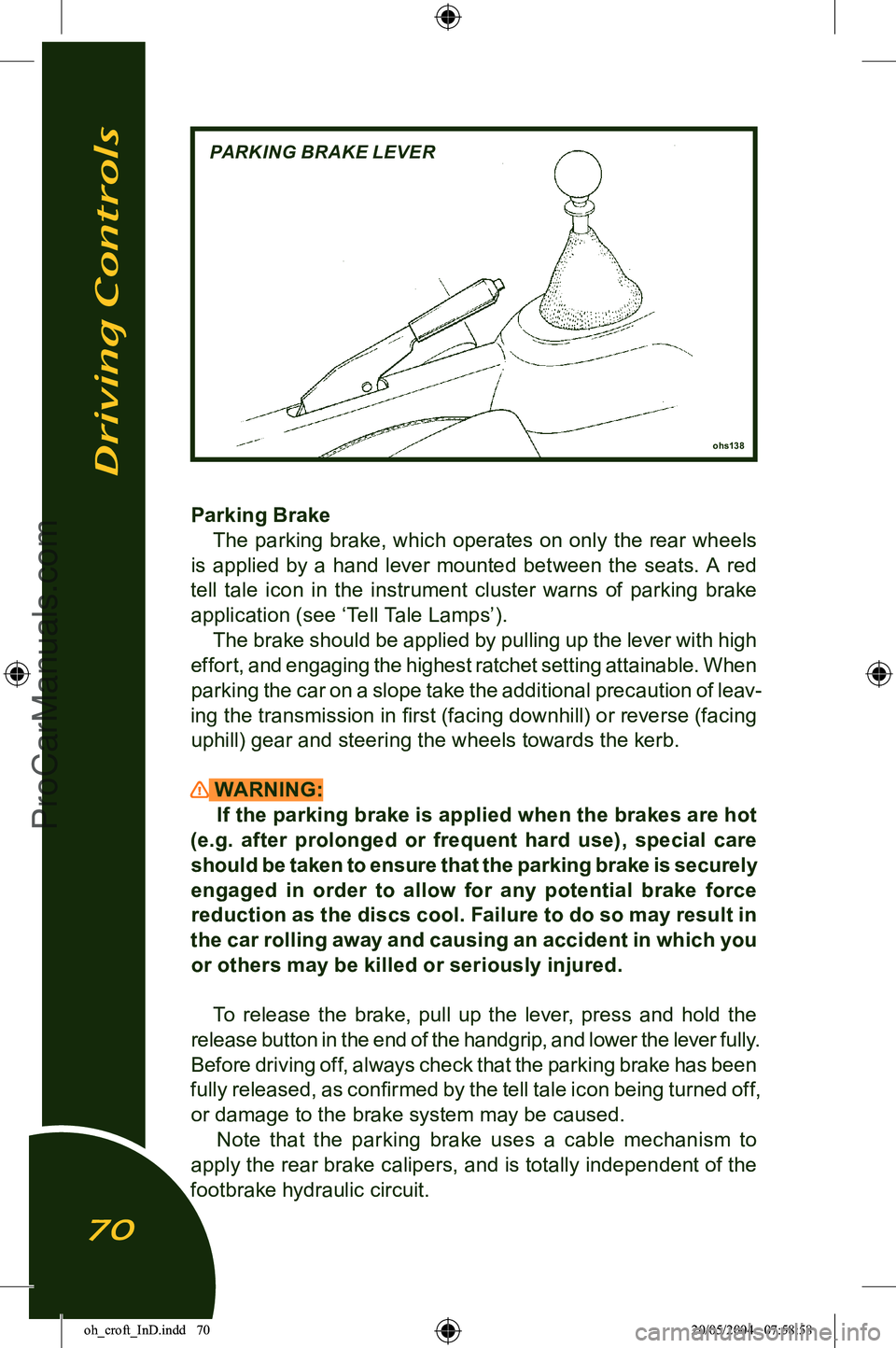
Parking BrakeThe parking brake, which operates on only the rear wheels
is applied by a hand lever mounted between the seats. A red
tell tale icon in the instrument cluster warns of parking brake application (see ‘Tell Tale Lamps’). The brake should be applied by pulling up the lever with high
effort, and engaging the highest ratchet setting attainable. When
parking the car on a slope take the additional precaution of leav
-
ing the transmission in first (facing downhill) or reverse (facing uphill) gear and steering the wheels towards the kerb.
WARNING: If the parking brake is applied when the brakes are hot
(e.g. after prolonged or frequent hard use), special care
should be taken to ensure that the parking brake is securely engaged in order to allow for any potential brake force
reduction as the discs cool. Failure to do so may result in
the car rolling away and causing an accident in which you
or others may be killed or seriously injured.
To release the brake, pull up the lever, press and hold the
release button in the end of the handgrip, and lower the lever fully.
Before driving off, always check that the parking brake has been
fully released, as confirmed by the tell tale icon being turned off,
or damage to the brake system may be caused. Note that the parking brake uses a cable mechanism to
apply the rear brake calipers, and is totally independent of the
footbrake hydraulic circuit.
Driving Controls
70
ohs138
PARKING BRAKE LEVER
oh_croft_InD.indd 7020/05/2004 07:58:58ProCarManuals.com
Page 73 of 205
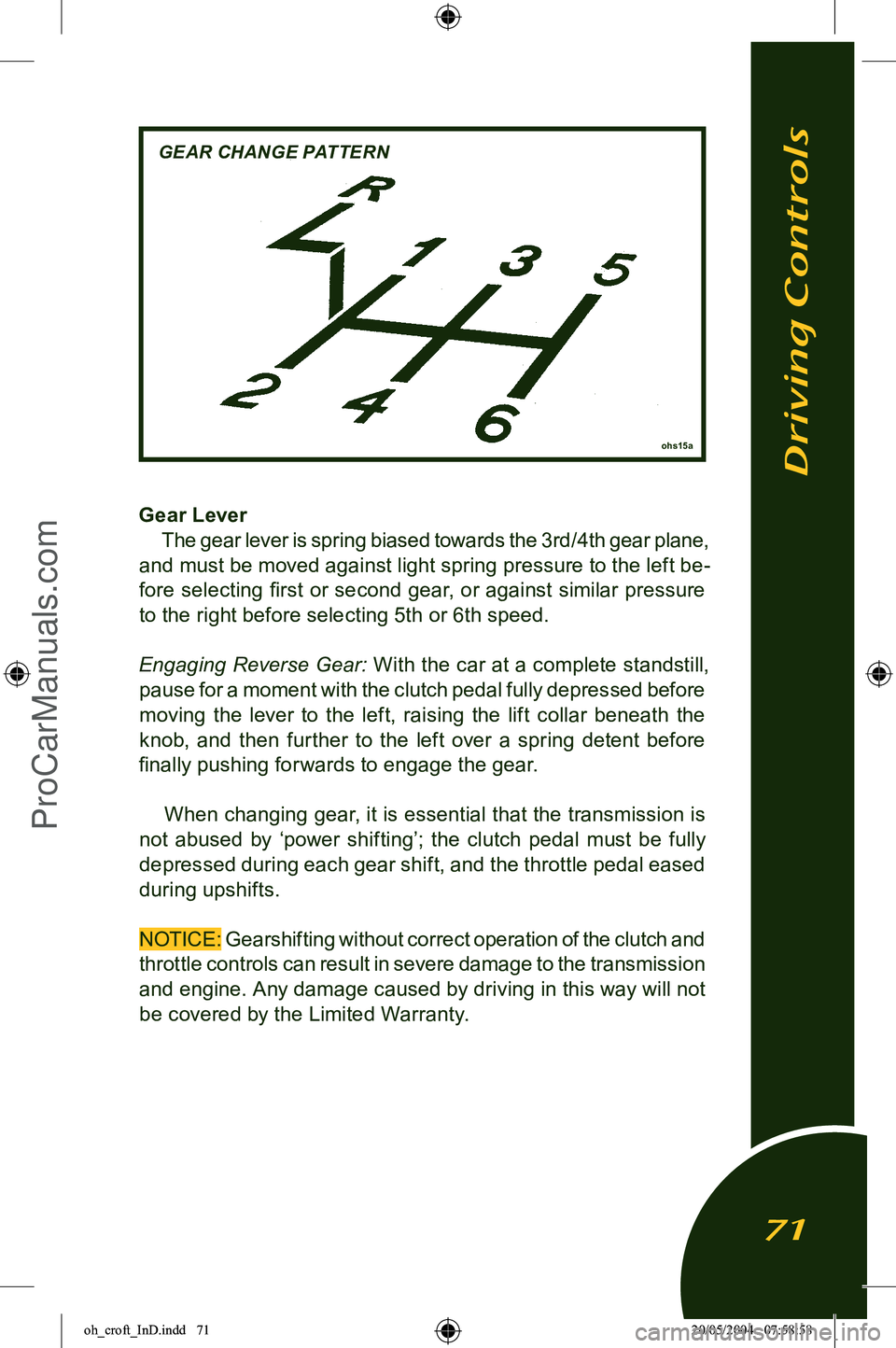
Gear LeverThe gear lever is spring biased towards the 3rd/4th gear plane,
and must be moved against light spring pressure to the left be
-
fore selecting first or second gear, or against similar pressure to the right before selecting 5th or 6th speed.
Engaging Reverse Gear: With the car at a complete standstill
,
pause for a moment with the clutch pedal fully depressed before
moving the lever to the left, raising the lift collar beneath the
knob, and then further to the left over a spring detent before
finally pushing forwards to engage the gear.
When changing gear, it is essential that the transmission is
not abused by ‘power shifting’; the clutch pedal must be fully
depressed during each gear shift, and the throttle pedal eased
during upshifts.
NOTICE: Gearshifting without correct operation of the clutch and
throttle controls can result in severe damage to the transmission
and engine. Any damage caused by driving in this way will not be covered by the Limited Warranty.
Driving Controls
71
ohs15a
GEAR CHANGE PATTERN
oh_croft_InD.indd 7120/05/2004 07:58:58ProCarManuals.com
Page 74 of 205
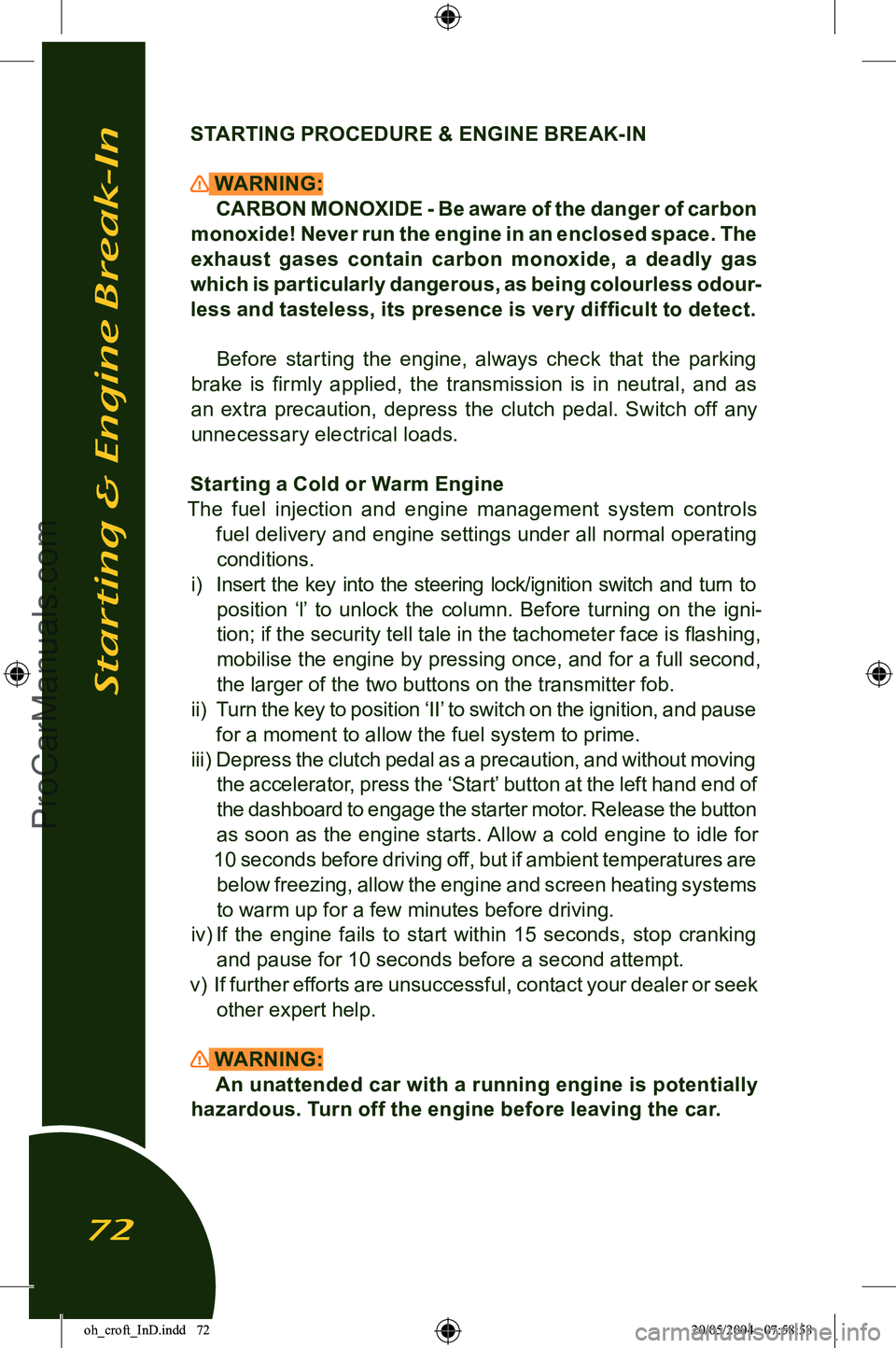
STARTING PROCEDURE & ENGINE BREAK-IN
WARNING:CARBON MONOXIDE - Be aware of the danger of carbon
monoxide! Never run the engine in an enclosed space. The
exhaust gases contain carbon monoxide, a deadly gas
which is particularly dangerous, as being colourless odour
-
less and tasteless, its presence is very difficult to detect.
Before starting the engine, always check that the parking
brake is firmly applied, the transmission is in neutral, and as
an extra precaution, depress the clutch pedal. Switch off any
unnecessary electrical loads.
Starting a Cold or Warm Engine
The fuel injection and engine management system controls fuel delivery and engine settings under all normal operating conditions.
i) Insert the key into the steering lock/ignition switch and turn to
position ‘l’ to unlock the column. Before turning on the igni
-
tion; if the security tell tale in the tachometer face is flashing, mobilise the engine by pressing once, and for a full second,
the larger of the two buttons on the transmitter fob.
ii) Turn the key to position ‘II’ to switch on the ignition, and pause
for a moment to allow the fuel system to prime.
iii) Depress the clutch pedal as a precaution, and without moving
the accelerator, press the ‘Start’ button at the left hand end of
the dashboard to engage the starter motor. Release the button
as soon as the engine starts. Allow a cold engine to idle for
10 seconds before driving off, but if ambient temperatures are below freezing, allow the engine and screen heating systems
to warm up for a few minutes before driving.
iv) If the engine fails to start within 15 seconds, stop cranking
and pause for 10 seconds before a second attempt.
v) If further efforts are unsuccessful, contact your dealer or seek
other expert help.
WARNING:
An unattended car with a running engine is potentially
hazardous. Turn off the engine before leaving the car.
Starting & Engine Break-In
72
oh_croft_InD.indd 7220/05/2004 07:58:58ProCarManuals.com
Page 75 of 205
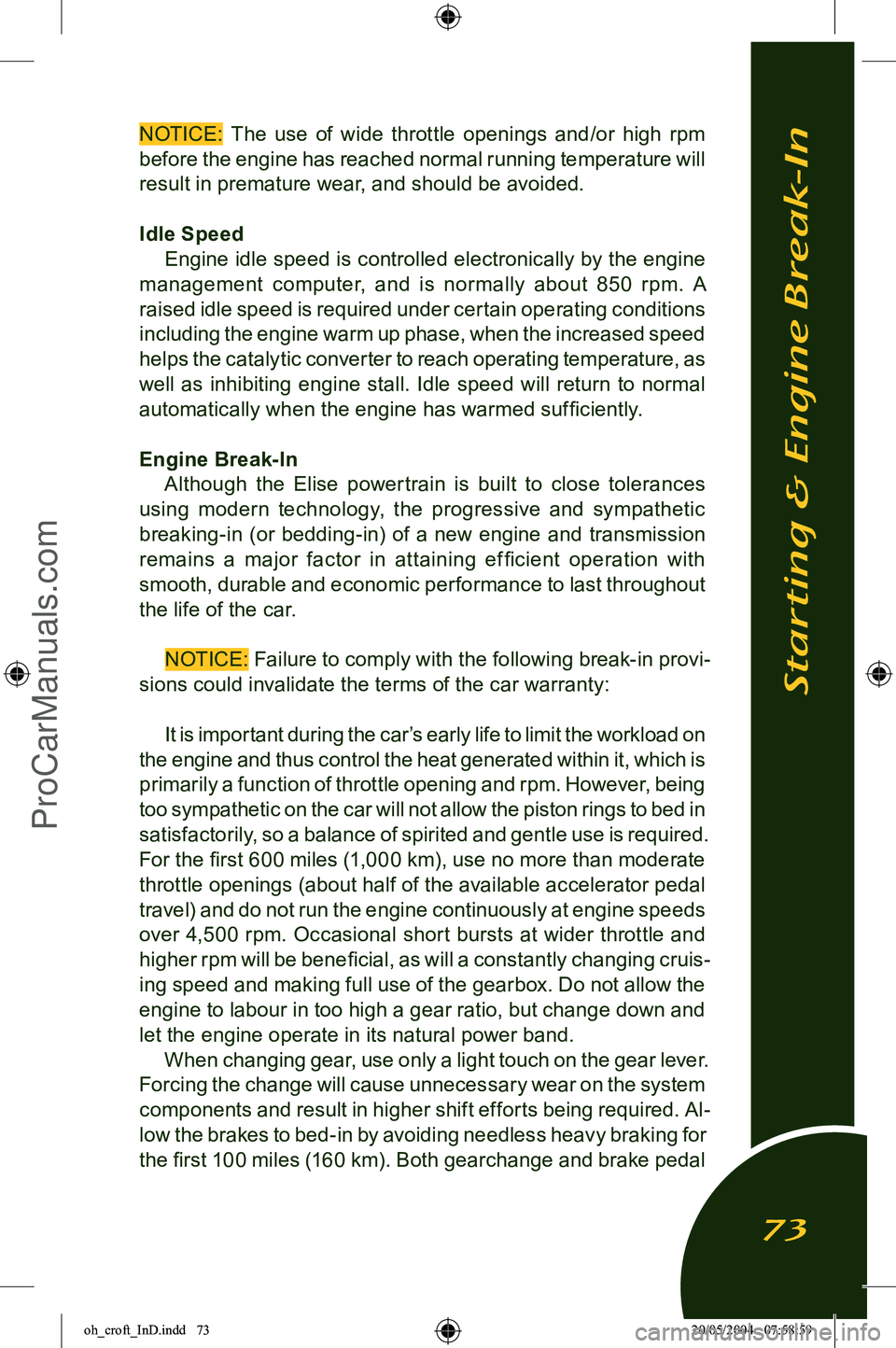
NOTICE: The use of wide throttle openings and/or high rpm before the engine has reached normal running temperature will
result in premature wear, and should be avoided.
Idle Speed Engine idle speed is controlled electronically by the engine
management computer, and is normally about 850 rpm. A
raised idle speed is required under certain operating conditions
including the engine warm up phase, when the increased speed helps the catalytic converter to reach operating temperature, as
well as inhibiting engine stall. Idle speed will return to normal automatically when the engine has warmed sufficiently.
Engine Break-In Although the Elise powertrain is built to close tolerances
using modern technology, the progressive and sympathetic
breaking-in (or bedding-in) of a new engine and transmission
remains a major factor in attaining ef ficient operation with
smooth, durable and economic performance to last throughout
the life of the car.
NOTICE: Failure to comply with the following break-in provi
-
sions could invalidate the terms of the car warranty:
It is important during the car’s early life to limit the workload on
the engine and thus control the heat generated within it, which is primarily a function of throttle opening and rpm. However, being
too sympathetic on the car will not allow the piston rings to bed in
satisfactorily, so a balance of spirited and gentle use is required.
For the first 600 miles (1,000 km), use no more than moderate
throttle openings (about half of the available accelerator pedal
travel) and do not run the engine continuously at engine speeds over 4,500 rpm. Occasional short bursts at wider throttle and
higher rpm will be beneficial, as will a constantly changing cruis
-
ing speed and making full use of the gearbox. Do not allow the
engine to labour in too high a gear ratio, but change down and
let the engine operate in its natural power band. When changing gear, use only a light touch on the gear lever.
Forcing the change will cause unnecessary wear on the system components and result in higher shift efforts being required. Al
-
low the brakes to bed-in by avoiding needless heavy braking for
the first 100 miles (160 km). Both gearchange and brake pedal
Starting & Engine Break-In
73
oh_croft_InD.indd 7320/05/2004 07:58:59ProCarManuals.com
Page 76 of 205
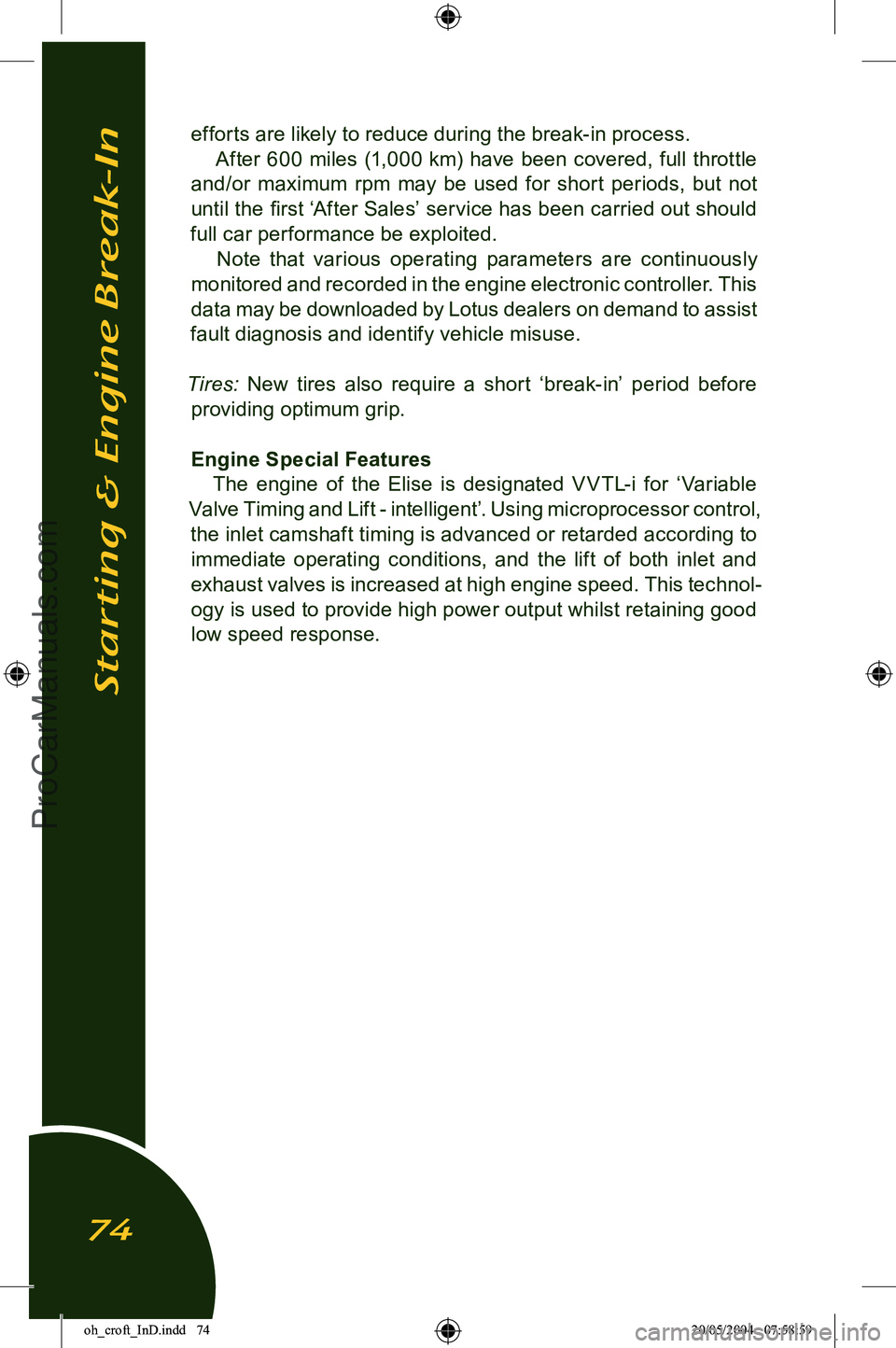
efforts are likely to reduce during the break-in process.After 600 miles (1,000 km) have been covered, full throttle
and/or maximum rpm may be used for short periods, but not
until the first ‘After Sales’ service has been carried out should
full car performance be exploited. Note that various operating parameters are continuously
monitored and recorded in the engine electronic controller. This
data may be downloaded by Lotus dealers on demand to assist
fault diagnosis and identify vehicle misuse.
Tires:
New tires also require a short ‘break-in’ period before
providing optimum grip.
Engine Special Features The engine of the Elise is designated V VTL-i for ‘Variable
Valve Timing and Lift - intelligent’. Using microprocessor control, the inlet camshaft timing is advanced or retarded according to
immediate operating conditions, and the lift of both inlet and
exhaust valves is increased at high engine speed. This technol
-
ogy is used to provide high power output whilst retaining good
low speed response.
Starting & Engine Break-In
74
oh_croft_InD.indd 7420/05/2004 07:58:59ProCarManuals.com
Page 77 of 205
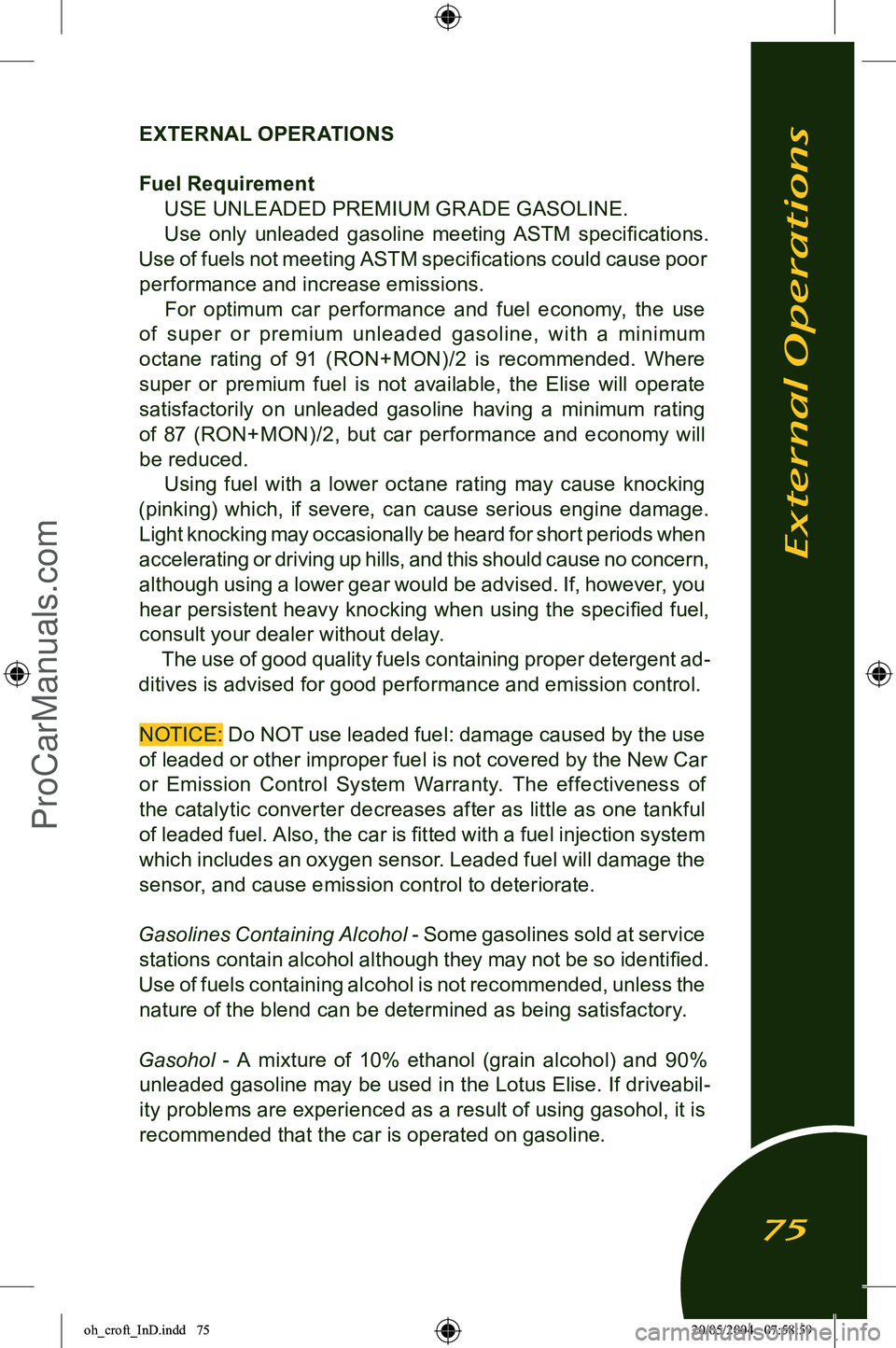
EXTERNAL OPERATIONS
Fuel Requirement USE UNLEADED PREMIUM GR ADE GASOLINE.
Use only unleaded gasoline meeting ASTM specifications.
Use of fuels not meeting ASTM specifications could cause poor performance and increase emissions.
For optimum car performance and fuel economy, the use
of super or premium unleaded gasoline, with a minimum
octane rating of 91 (RON+MON)/2 is recommended. Where
super or premium fuel is not available, the Elise will operate
satisfactorily on unleaded gasoline having a minimum rating
of 87 (RON+MON)/2, but car performance and economy will be reduced. Using fuel with a lower octane rating may cause knocking
(pinking) which, if severe, can cause serious engine damage.
Light knocking may occasionally be heard for short periods when accelerating or driving up hills, and this should cause no concern,
although using a lower gear would be advised. If, however, you hear persistent heavy knocking when using the specified fuel,
consult your dealer without delay.
The use of good quality fuels containing proper detergent ad
-
ditives is advised for good performance and emission control.
NOTICE: Do NOT use leaded fuel: damage caused by the use of leaded or other improper fuel is not covered by the New Car
or Emission Control System Warranty. The effectiveness of
the catalytic converter decreases after as little as one tankful
of leaded fuel. Also, the car is fitted with a fuel injection system
which includes an oxygen sensor. Leaded fuel will damage the sensor, and cause emission control to deteriorate.
Gasolines Containing Alcohol - Some gasolines sold at service stations contain alcohol although they may not be so identified.
Use of fuels containing alcohol is not recommended, unless the nature of the blend can be determined as being satisfactory.
Gasohol - A mixture of 10% ethanol (grain alcohol) and 90% unleaded gasoline may be used in the Lotus Elise. If driveabil
-
ity problems are experienced as a result of using gasohol, it is recommended that the car is operated on gasoline.
External Operations
75
oh_croft_InD.indd 7520/05/2004 07:58:59ProCarManuals.com
Page 78 of 205
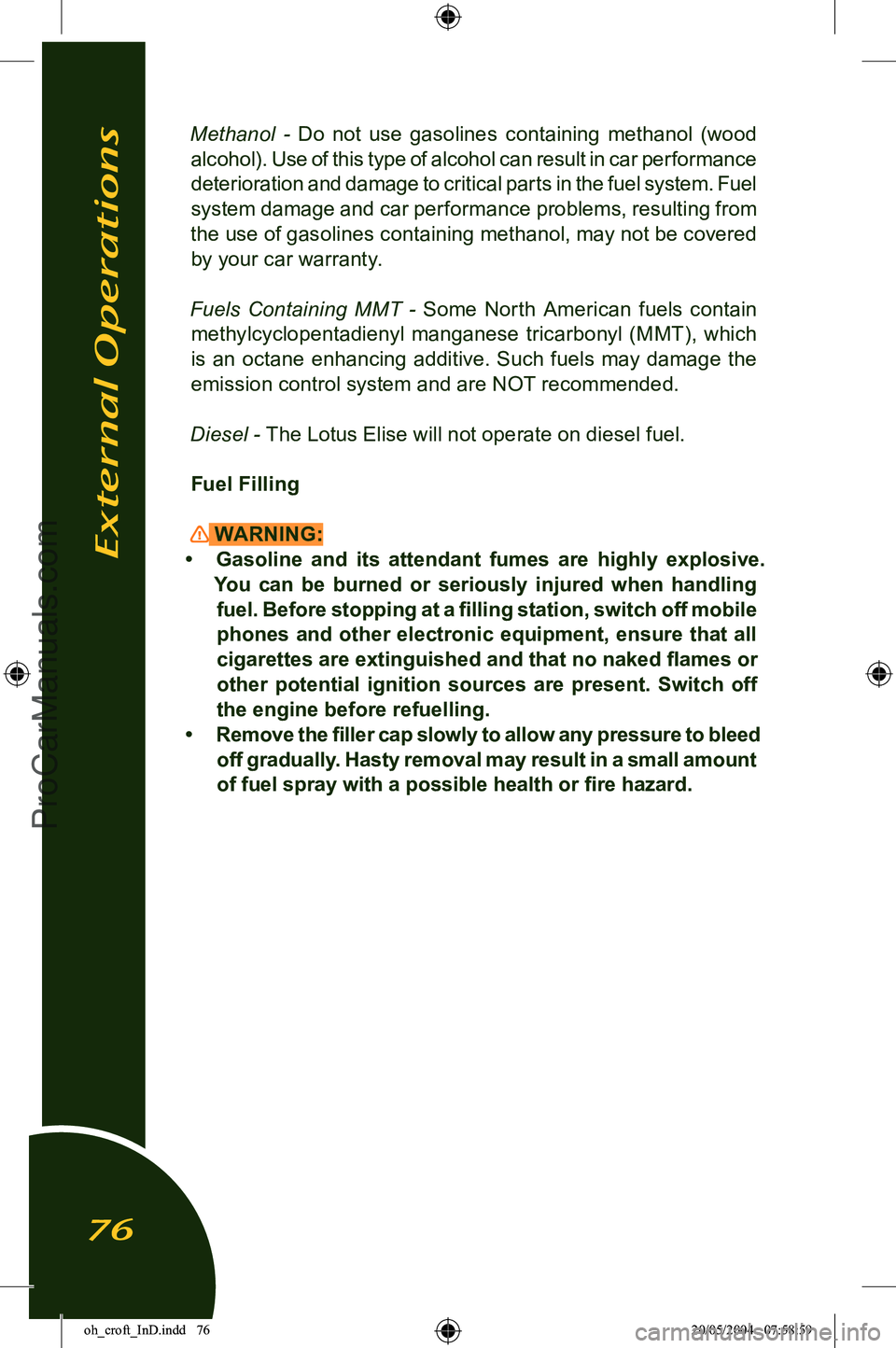
Methanol - Do not use gasolines containing methanol (wood
alcohol). Use of this type of alcohol can result in car performance deterioration and damage to critical parts in the fuel system. Fuel
system damage and car performance problems, resulting from
the use of gasolines containing methanol, may not be covered by your car warranty.
Fuels Containing MMT - Some North American fuels contain methylcyclopentadienyl manganese tricarbonyl (MMT), which
is an octane enhancing additive. Such fuels may damage the
emission control system and are NOT recommended.
Diesel
- The Lotus Elise will not operate on diesel fuel.
Fuel Filling
WARNING:
• Gasoline and its attendant fumes are highly explosive. You can be burned or seriously injured when handling
fuel. Before stopping at a filling station, switch off mobile phones and other electronic equipment, ensure that all
cigarettes are extinguished and that no naked flames or
other potential ignition sources are present. Switch off
the engine before refuelling.
• Remove the filler cap slowly to allow any pressure to bleed off gradually. Hasty removal may result in a small amount
of fuel spray with a possible health or fire hazard. External Operations
76
oh_croft_InD.indd 7620/05/2004 07:58:59ProCarManuals.com
Page 79 of 205
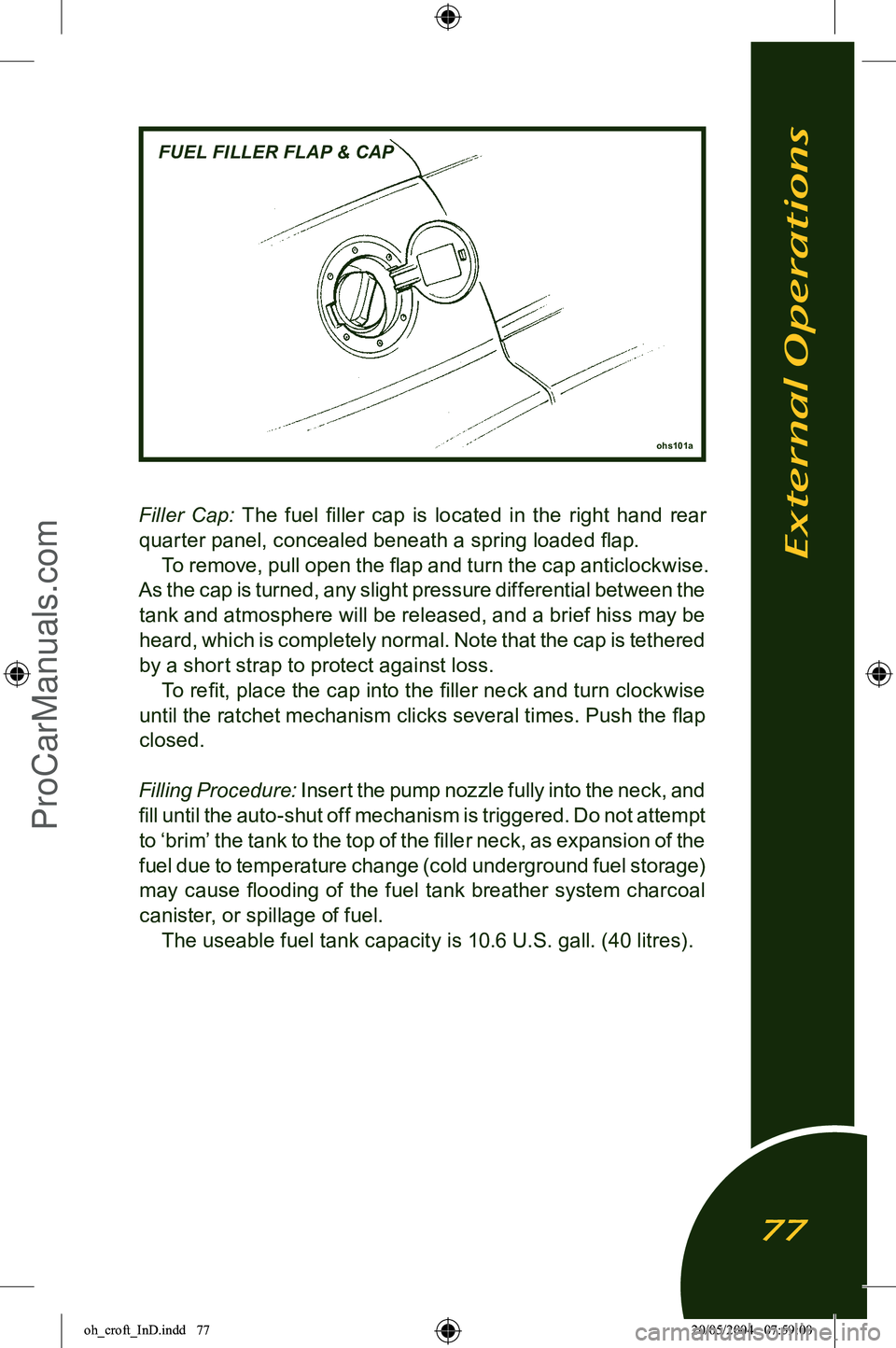
Filler Cap: The fuel filler cap is located in the right hand rear
quarter panel, concealed beneath a spring loaded flap. To remove, pull open the flap and turn the cap anticlockwise.
As the cap is turned, any slight pressure differential between the tank and atmosphere will be released, and a brief hiss may be heard, which is completely normal. Note that the cap is tethered by a short strap to protect against loss.
To refit, place the cap into the filler neck and turn clockwise
until the ratchet mechanism clicks several times. Push the flap closed.
Filling Procedure:
Insert the pump nozzle fully into the neck, and
fill until the auto-shut off mechanism is triggered. Do not attempt to ‘brim’ the tank to the top of the filler neck, as expansion of the
fuel due to temperature change (cold underground fuel storage) may cause flooding of the fuel tank breather system charcoal
canister, or spillage of fuel. The useable fuel tank capacity is 10.6 U.S. gall. (40 litres).
ohs101a
FUEL FILLER FLAP & CAP
External Operations
77
oh_croft_InD.indd 7720/05/2004 07:59:00ProCarManuals.com
Page 80 of 205
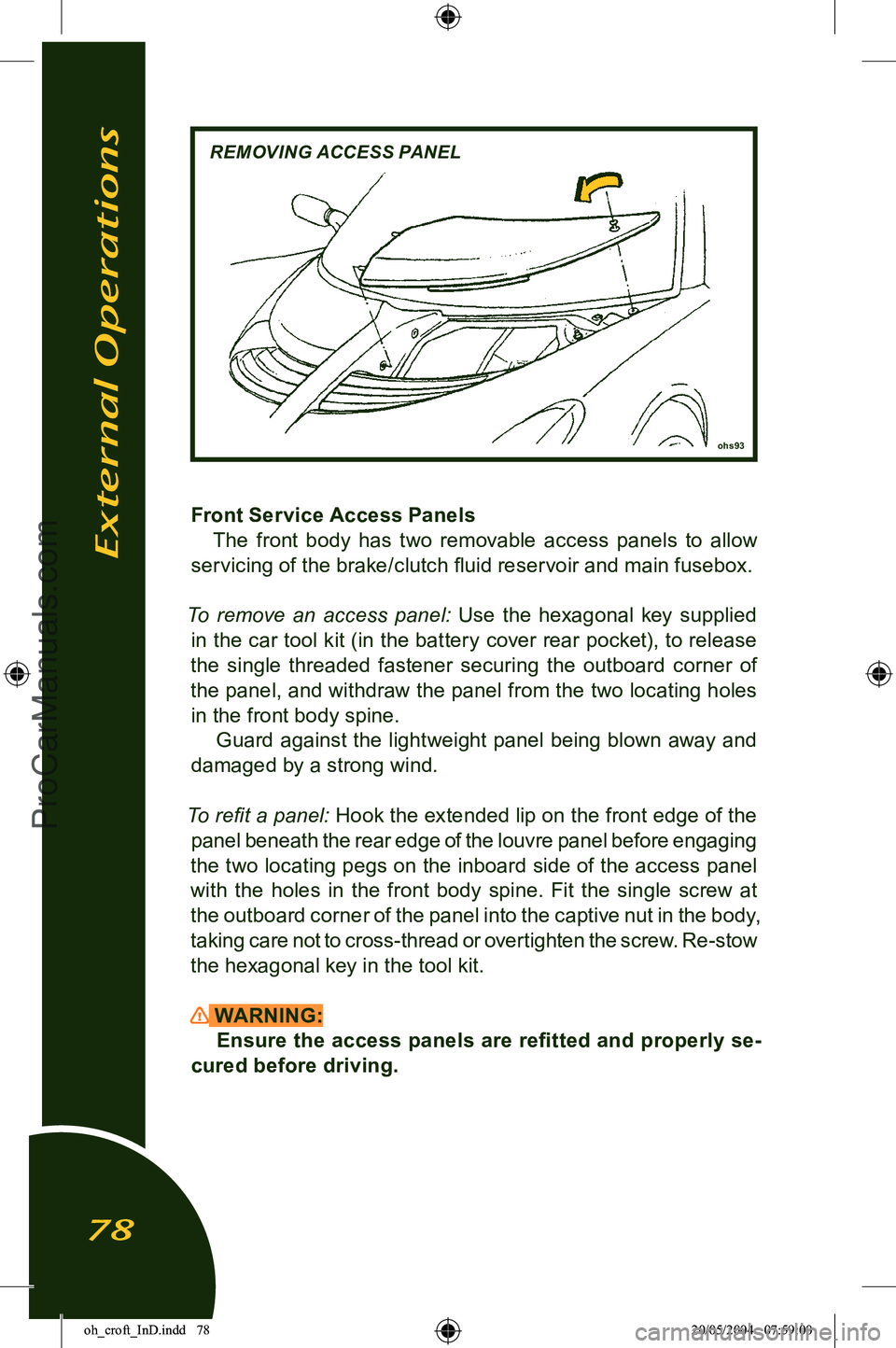
ohs93
REMOVING ACCESS PANEL
Front Service Access PanelsThe front body has two removable access panels to allow
servicing of the brake/clutch fluid reservoir and main fusebox.
To remove an access panel:
Use the hexagonal key supplied
in the car tool kit (in the battery cover rear pocket), to release
the single threaded fastener securing the outboard corner of
the panel, and withdraw the panel from the two locating holes in the front body spine. Guard against the lightweight panel being blown away and
damaged by a strong wind.
To refit a panel: Hook the extended lip on the front edge of the panel beneath the rear edge of the louvre panel before engaging
the two locating pegs on the inboard side of the access panel
with the holes in the front body spine. Fit the single screw at
the outboard corner of the panel into the captive nut in the body,
taking care not to cross-thread or overtighten the screw. Re-stow
the hexagonal key in the tool kit.
WARNING: Ensure the access panels are refitted and properly se
-
cured before driving.
External Operations
78
oh_croft_InD.indd 7820/05/2004 07:59:00ProCarManuals.com